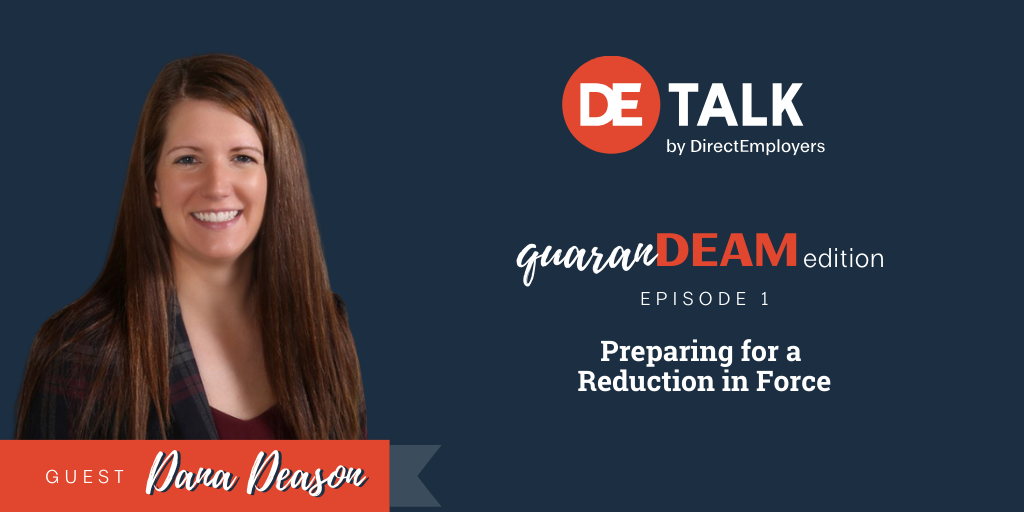Season One of the DE Talk podcast wrapped back in March but in light of the cancellation of our 2020 Annual Meeting & Conference (DEAMcon20), we decided to keep the conversation going and spin out a few QuaranDEAM Edition episodes to help HR pros with challenges they may be facing in these uncertain times. So, let’s get into episode one!
As the COVID-19 pandemic continues, many companies are facing challenges they’ve never had to consider in the past. Furloughs, layoffs and reductions in force are becoming commonplace and not all are prepared to handle it–especially in a way that won’t result in legal backlash. DE Talk host and DirectEmployers Executive Director Candee Chambers sat down with ArcBest Senior Manager, HR Admin and Compliance Dana Deason to discuss tips and best practices to help prepare for a reduction in force. Take a look at these snippets from the conversation and then be sure to listen to the full episode for more invaluable information.
Candee Chambers:
As I said, at the very beginning, I’ve been through a lot of reductions in force and it’s never a good time, but now, there’s so many things to pay attention to. And I mean, the lawyers are saying that this is kind of a payday for plaintiff lawyers because if you don’t get it right, you could be in big trouble. So we’ll talk about that I’m sure a little bit more, but what would you recommend that we need to know, then, in order to stay out of hot water and to make sure that we don’t get into trouble?
Dana Deason:
So as a general rule, when there’s a lot of pressure to move quickly, that’s when human resources can really step in and be a guide, and it is necessary to move quickly and respond, but it’s time well spent to review discussions which impact your team members and spending a little time preparing on the front-end can save a lot of time and trouble when it is time to make those decisions. And if your company isn’t facing this scenario right now, which I hope that it’s not, I do highly recommended defining what the process should look like and then get on the same page internally about your terminology that you’ll use. I saw in a response John Fox explained “furlough” as a sort of a made up word that human resource companies are trying to use right now and it’s true.
I also can’t stress this enough. Ensure you’re working closely with counsel. Obviously you don’t want to take anything that I’m saying in this conversation as, “what you should do for your organization.” But what legal counsel has advised us is that separation decisions should occur based on tenure beginning with the least amount of time with the company or in the role, unless there’s a compelling and highly documented reason to handle that differently. I don’t know if that coincides with what advice you’ve been given, Candee.
Candee Chambers:
Yes. And you know what, I like your comment about working with legal counsel because you also have to look very closely at age because if you are doing a reduction in force for people over 40, you have to really be careful that there’s no…and I know, I think you’re going to talk a little bit about some of the adverse impact that could happen, you really have to be careful and make sure that you’re terminating the right people for the right reasons.
Dana Deason:
Within that, you want to review the employees who were selected to ensure that it was reasonable logic that you can defend, and that the logic was used consistently, not to cherry pick. And then also consider conducting analysis to see if there was any kind of adverse impact, a disparate impact against protected groups, and of course, you want to do that under attorney-client privilege. And then only conduct that analysis if you plan to do something about it or dig deeper to determine if that was the only course of action–or if there’s an alternate option. And then if you use a selection criteria other than tenure, that’s where I would definitely consider doing an analysis of who was selected.
Candee Chambers:
Definitely. And to your point, you have to make sure that there isn’t a disparate impact to African Americans or Hispanics or Asians or women, or people over 40, people with disabilities, etc. You really have to make sure that there’s not an abnormal reliance on people in a protected class. And especially if you use something other than tenure, to your point Dana, and I was happy that you brought this up. A well-documented performance situation or a performance improvement plan, it has to be defendable, which you said. So I don’t think people necessarily think about that in the midst of everything that’s going on but you’ve got to have your ducks in a row and it’s never easy, it’s never anything anyone in HR likes to do. So…what about severance?
To see how Dana recommends handling severance during a reduction in force, as well as how to maintain morale and mental health of employees who stay on the job, to listen to the full conversation, or find DE Talk in your favorite podcast provider app!


